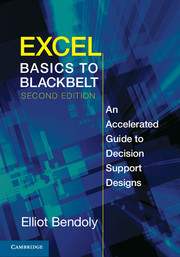Book contents
- Frontmatter
- Contents
- Associated Links
- Preface
- Section 1 Getting Oriented
- 1 Necessary Foundations for Decision Support
- 2 The Development Environment
- 3 Getting Data: Acquisition, Linkage, and Generation
- Section 2 Harvesting Intelligence
- Section 3 Leveraging Dynamic Analysis
- Section 4 Advanced Automation and Interfacing
- Glossary of Key Terms
- Appendix: Shortcut (Hot Key) Reference
- Index
2 - The Development Environment
Published online by Cambridge University Press: 05 August 2013
- Frontmatter
- Contents
- Associated Links
- Preface
- Section 1 Getting Oriented
- 1 Necessary Foundations for Decision Support
- 2 The Development Environment
- 3 Getting Data: Acquisition, Linkage, and Generation
- Section 2 Harvesting Intelligence
- Section 3 Leveraging Dynamic Analysis
- Section 4 Advanced Automation and Interfacing
- Glossary of Key Terms
- Appendix: Shortcut (Hot Key) Reference
- Index
Summary
Before attempting to construct a home, architects and builders need to know what resources they have at their disposal and how they can access these resources. The same holds in decision support development, but as you'll learn in subsequent chapters, the tools available to Excel developers are more numerous than a typical user would imagine. In this chapter, we'll start with the low-hanging fruit by becoming acquainted with the general nature of Excel's front-end development environment. Figure 2.1 provides an annotated view of what people typically see when they open a new file in Excel. Only a few key elements of this interface are central to our initial discussion.
Excel files are called “workbooks.” They contain any number of worksheets (spreadsheets) that can be used in tandem. For the vast majority of its use in practice Excel is relegated to storing information. This is largely because most users don't know what else Excel can do. Not that storing information in Excel is bad, but there are often better alternatives available for storage, such as databases, in the case of very large sets of data. Functionally, the storage capability of Excel represents only the bare tip of this technological iceberg.
- Type
- Chapter
- Information
- Excel Basics to BlackbeltAn Accelerated Guide to Decision Support Designs, pp. 7 - 36Publisher: Cambridge University PressPrint publication year: 2013



